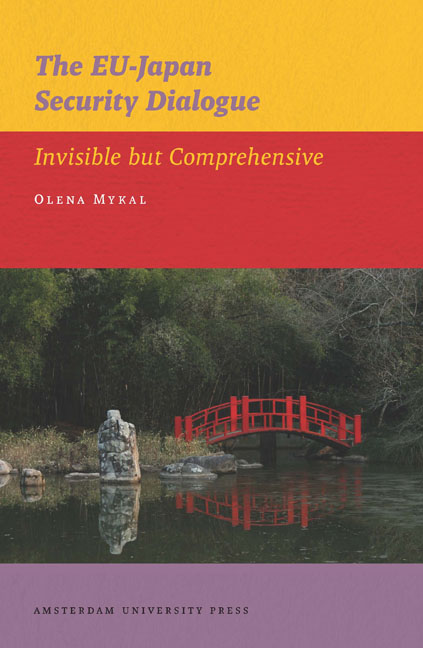Book contents
- Frontmatter
- Dedication
- Contents
- Abbreviations
- Acknowledgements
- Preface
- Introduction
- PART ONE DEVELOPING CONCEPTIONS OF SECURITY AND JOINT AGENDA OF THE EU-JAPAN SECURITY DIALOGUE
- PART TWO COMMON INTERESTS IN THE EU-JAPAN SECURITY DIALOGUE: ANALYSIS OF JOINT ACTIVITIES
- Conclusion
- About the Author
- Notes
- Bibliography
- Index
- Publications Series
7 - Japan and EU Involvement in Crisis Management: Joint Activities
Published online by Cambridge University Press: 22 January 2021
- Frontmatter
- Dedication
- Contents
- Abbreviations
- Acknowledgements
- Preface
- Introduction
- PART ONE DEVELOPING CONCEPTIONS OF SECURITY AND JOINT AGENDA OF THE EU-JAPAN SECURITY DIALOGUE
- PART TWO COMMON INTERESTS IN THE EU-JAPAN SECURITY DIALOGUE: ANALYSIS OF JOINT ACTIVITIES
- Conclusion
- About the Author
- Notes
- Bibliography
- Index
- Publications Series
Summary
Chapter 2 established that, since the early 1990s, the EU and Japan have been engaged in crisis management operations. This area has appeared on the bilateral agenda since the very beginning of the political dialogue initiated by The Hague Declaration in 1991 and, since then, has been a regular part of the security dialogue. Moreover, as demonstrated in chapter 2, this activity was not given a specific word. Officially labelling activities connected to crisis management can be traced back to Japan's Foreign Minister Yohei Kono's speech in which he proposed reinforcing relations between the EU and Japan in the areas of conflict prevention and post-conflict rehabilitation. Furthermore, their involvement in crisis management activity has mostly been of a civilian nature, i.e. without military force. It has been in line with the EU and Japan's security conceptualisations.
This chapter will examine the concrete joint projects in which the EU and Japan have been involved in the area of crisis management. Its main argument is that, despite their invisibility, the EU and Japan have been intensively engaged in joint crisis management projects since the end of the Cold War. It also argues that the security dialogue has been widening and strengthening with the addition of new sectors for collaboration in reaction to new challenges and threats, and proceeding from their ‘civilian power’ identities.
This chapter is organised into two distinct parts: first, we examine the EU and Japan's involvement in concrete conflicts and their resolution in the world. This part is divided into eight subparts, each of which analyses the EU and Japanese collective performance in a certain country or region. The second part deals with an examination of their activities on a global scale regardless of regions, as their collaboration has been aimed at the maintenance of global security. It primarily focuses on EU and Japanese measures regarding counter-terrorism and, secondly, on conflict prevention and peace-building measures.
Dividing the chapter by geography rather than time is reasonable and justified because some of the activities have focused on a specific region or a country for a long time, e.g. North Korea, the Balkans, while others have occurred worldwide, e.g. the fight against terrorism.
- Type
- Chapter
- Information
- The EU-Japan Security DialogueInvisible but Comprehensive, pp. 175 - 200Publisher: Amsterdam University PressPrint publication year: 2012



